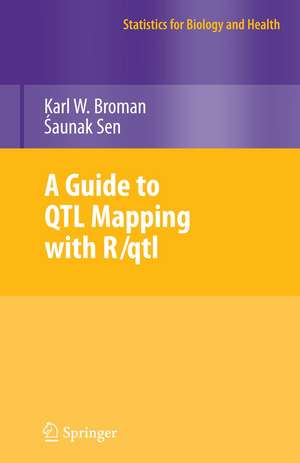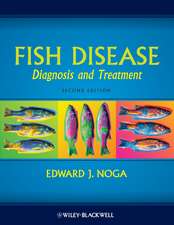A Guide to QTL Mapping with R/qtl: Statistics for Biology and Health
Autor Karl W. Broman, Saunak Senen Limba Engleză Paperback – 2 dec 2011
The book alternates between QTL mapping theory and examples illustrating the use of R/qtl. Novice readers will find detailed explanations of the important statistical concepts and, through the extensive software illustrations, will be able to apply these concepts in their own research. Experienced readers will find details on the underlying algorithms and the implementation of extensions to R/qtl. There are 150 figures, including 90 in full color.
| Toate formatele și edițiile | Preț | Express |
|---|---|---|
| Paperback (1) | 1380.47 lei 6-8 săpt. | |
| Springer – 2 dec 2011 | 1380.47 lei 6-8 săpt. | |
| Hardback (1) | 1394.84 lei 6-8 săpt. | |
| Springer – 20 iul 2009 | 1394.84 lei 6-8 săpt. |
Din seria Statistics for Biology and Health
- 20%
 Preț: 633.23 lei
Preț: 633.23 lei - 17%
 Preț: 352.01 lei
Preț: 352.01 lei - 20%
 Preț: 758.04 lei
Preț: 758.04 lei - 20%
 Preț: 1379.34 lei
Preț: 1379.34 lei - 18%
 Preț: 1394.84 lei
Preț: 1394.84 lei - 18%
 Preț: 883.59 lei
Preț: 883.59 lei - 5%
 Preț: 843.91 lei
Preț: 843.91 lei -
 Preț: 397.16 lei
Preț: 397.16 lei - 20%
 Preț: 1002.67 lei
Preț: 1002.67 lei - 18%
 Preț: 1395.32 lei
Preț: 1395.32 lei - 5%
 Preț: 1102.10 lei
Preț: 1102.10 lei - 5%
 Preț: 874.83 lei
Preț: 874.83 lei - 15%
 Preț: 657.39 lei
Preț: 657.39 lei - 18%
 Preț: 960.93 lei
Preț: 960.93 lei - 15%
 Preț: 585.90 lei
Preț: 585.90 lei - 5%
 Preț: 852.69 lei
Preț: 852.69 lei - 18%
 Preț: 903.62 lei
Preț: 903.62 lei - 5%
 Preț: 721.40 lei
Preț: 721.40 lei - 15%
 Preț: 653.46 lei
Preț: 653.46 lei - 18%
 Preț: 2114.90 lei
Preț: 2114.90 lei - 18%
 Preț: 1108.99 lei
Preț: 1108.99 lei - 5%
 Preț: 821.39 lei
Preț: 821.39 lei - 5%
 Preț: 849.02 lei
Preț: 849.02 lei - 15%
 Preț: 653.14 lei
Preț: 653.14 lei - 18%
 Preț: 958.56 lei
Preț: 958.56 lei - 5%
 Preț: 722.69 lei
Preț: 722.69 lei - 18%
 Preț: 728.74 lei
Preț: 728.74 lei - 18%
 Preț: 943.22 lei
Preț: 943.22 lei - 5%
 Preț: 1092.43 lei
Preț: 1092.43 lei - 15%
 Preț: 594.21 lei
Preț: 594.21 lei - 5%
 Preț: 377.87 lei
Preț: 377.87 lei - 18%
 Preț: 1124.60 lei
Preț: 1124.60 lei - 18%
 Preț: 1220.12 lei
Preț: 1220.12 lei - 15%
 Preț: 632.98 lei
Preț: 632.98 lei - 18%
 Preț: 1394.84 lei
Preț: 1394.84 lei -
 Preț: 389.11 lei
Preț: 389.11 lei - 18%
 Preț: 959.98 lei
Preț: 959.98 lei
Preț: 1380.47 lei
Preț vechi: 1683.50 lei
-18% Nou
Puncte Express: 2071
Preț estimativ în valută:
264.15€ • 275.14$ • 220.20£
264.15€ • 275.14$ • 220.20£
Carte tipărită la comandă
Livrare economică 28 martie-11 aprilie
Preluare comenzi: 021 569.72.76
Specificații
ISBN-13: 9781461417088
ISBN-10: 1461417082
Pagini: 416
Ilustrații: XII, 400 p. 151 illus., 87 illus. in color.
Dimensiuni: 155 x 235 x 22 mm
Greutate: 0.58 kg
Ediția:2009
Editura: Springer
Colecția Springer
Seria Statistics for Biology and Health
Locul publicării:New York, NY, United States
ISBN-10: 1461417082
Pagini: 416
Ilustrații: XII, 400 p. 151 illus., 87 illus. in color.
Dimensiuni: 155 x 235 x 22 mm
Greutate: 0.58 kg
Ediția:2009
Editura: Springer
Colecția Springer
Seria Statistics for Biology and Health
Locul publicării:New York, NY, United States
Public țintă
Professional/practitionerCuprins
Importing and simulating data.- Data checking.- Single-QTL analysis.- Non-normal phenotypes.- Experimental design and power.- Working with covariates.- Two-dimensional, two-QTL scans.- Fit and exploration of multiple-QTL models.- Case study I.- Case study II.
Recenzii
From the reviews:
“The book by Broman and Sen gives a practical review of statistical QTL mapping in experimental crosses with step-by-step instructions to the use of the R package qtl. …has a wide coverage of topics, from experimental design and data input, to single-QTL mapping, mapping with covariates and multiple-GTL scans, organized into 11 chapters according to the logic flow of a QTL analysis. The authors made a good compromise between statistical methodology and real-data illustration with R code, so that different readers may easily focus on the parts that are more interesting to them. A researcher can follow the code in the examples of the book to study real-data applications of the qtl package. …this is a well-written book with carefully chosen and nicely organized topics. It can serve as a good introduction to QTL mapping methodology and a useful practical guide to the R package. …” (Journal of Statistical Software, Vol. 32, Book Review 5, January 2010)
“The book gives an overview of the practical aspects of the analysis of QTL mapping experiments … . Most of the chapters start with a short introduction and finish with a summary and suggestions of further reading listing numerous review articles connected with the discussed subject. … There are 150 figures, including 90 in full color. We recommend it, first of all, to scientists who use QTL mapping analysis, and also to postdoctoral researchers and graduated students interested in exploring applications of statistics.” (I. Czyczyło-Mysza and I. Marcińska, Acta Physiologiae Plantarum, Vol. 32, March, 2010)
“The book by Broman and Sen gives a practical review of statistical QTL mapping in experimental crosses with step-by-step instructions to the use of the R package qtl. …has a wide coverage of topics, from experimental design and data input, to single-QTL mapping, mapping with covariates and multiple-GTL scans, organized into 11 chapters according to the logic flow of a QTL analysis. The authors made a good compromise between statistical methodology and real-data illustration with R code, so that different readers may easily focus on the parts that are more interesting to them. A researcher can follow the code in the examples of the book to study real-data applications of the qtl package. …this is a well-written book with carefully chosen and nicely organized topics. It can serve as a good introduction to QTL mapping methodology and a useful practical guide to the R package. …” (Journal of Statistical Software, Vol. 32, Book Review 5, January 2010)
“The book gives an overview of the practical aspects of the analysis of QTL mapping experiments … . Most of the chapters start with a short introduction and finish with a summary and suggestions of further reading listing numerous review articles connected with the discussed subject. … There are 150 figures, including 90 in full color. We recommend it, first of all, to scientists who use QTL mapping analysis, and also to postdoctoral researchers and graduated students interested in exploring applications of statistics.” (I. Czyczyło-Mysza and I. Marcińska, Acta Physiologiae Plantarum, Vol. 32, March, 2010)
Textul de pe ultima copertă
Quantitative trait locus (QTL) mapping is used to discover the genetic and molecular architecture underlying complex quantitative traits. It has important applications in agricultural, evolutionary, and biomedical research. R/qtl is an extensible, interactive environment for QTL mapping in experimental crosses. It is implemented as a package for the widely used open source statistical software R and contains a diverse array of QTL mapping methods, diagnostic tools for ensuring high-quality data, and facilities for the fit and exploration of multiple-QTL models, including QTL x QTL and QTL x environment interactions. This book is a comprehensive guide to the practice of QTL mapping and the use of R/qtl, including study design, data import and simulation, data diagnostics, interval mapping and generalizations, two-dimensional genome scans, and the consideration of complex multiple-QTL models. Two moderately challenging case studies illustrate QTL analysis in its entirety.
The book alternates between QTL mapping theory and examples illustrating the use of R/qtl. Novice readers will find detailed explanations of the important statistical concepts and, through the extensive software illustrations, will be able to apply these concepts in their own research. Experienced readers will find details on the underlying algorithms and the implementation of extensions to R/qtl. There are 150 figures, including 90 in full color.
Karl W. Broman is Professor in the Department of Biostatistics and Medical Informatics at the University of Wisconsin-Madison, and is the chief developer of R/qtl. Saunak Sen is Associate Professor in Residence in the Department of Epidemiology and Biostatistics and the Center for Bioinformatics and Molecular Biostatistics at the University of California, San Francisco.
The book alternates between QTL mapping theory and examples illustrating the use of R/qtl. Novice readers will find detailed explanations of the important statistical concepts and, through the extensive software illustrations, will be able to apply these concepts in their own research. Experienced readers will find details on the underlying algorithms and the implementation of extensions to R/qtl. There are 150 figures, including 90 in full color.
Karl W. Broman is Professor in the Department of Biostatistics and Medical Informatics at the University of Wisconsin-Madison, and is the chief developer of R/qtl. Saunak Sen is Associate Professor in Residence in the Department of Epidemiology and Biostatistics and the Center for Bioinformatics and Molecular Biostatistics at the University of California, San Francisco.
Caracteristici
Gives an overview of the practical aspects of the analysis of QTL mapping experiments based on inbred line crosses, with explicit instructions on the use of the R/qtl software




